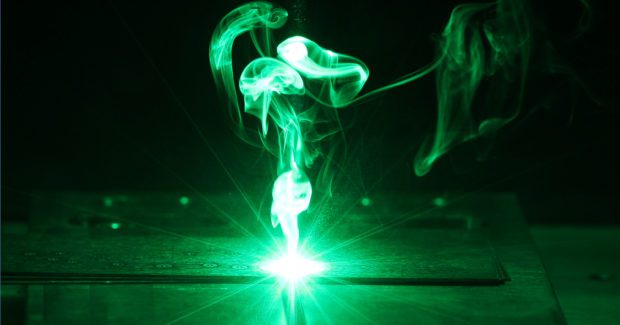Advanced Metal Joining with Laser Welding
Laser welding is becoming more common to a wider audience that is discovering how its unique properties can create stronger and more aesthetic weld seams than conventional GMAW processes, and how it can tackle weld geometries that were once impractical or downright impossible.
Posted: February 6, 2018
The laser welding of metals as a manufacturing technique has been around for decades, although for many years it was mainly reserved for applications requiring substantial volumes (such as automotive body in white) or highly specialized requirements that could not be met with conventional welding processes. In the last few years, however, scientific advances in laser welding have converged with improvements in enabling technologies like laser sources and delivery systems that make laser welding a more advantageous manufacturing process – and one applicable to a much wider audience. The unique properties of laser welding allow for weld seams that can be stronger and more aesthetic than those produced with conventional GMAW processes. Laser welding also opens up new possibilities for product design, with the ability to tackle weld geometries that would have been impractical or downright impossible before.
The ability to weld metals with minimal heat input means that laser welding has the potential to tackle projects, such as critical aerospace components, that simply cannot be done with conventional welding techniques due to the high heat generation. Another important fact is that laser welding can potentially deliver two very different welding processes in one system: heat conduction welding and deep penetration welding. These two styles of welding are each ideally suited for different applications, and fully-integrated laser welding systems offer the ability to switch easily between these two types of welding processes, expanding the range of products that can be effectively welded by a single piece of equipment. This flexibility opens the door to implementation of automated laser welding in contract manufacturing environments where a broad range of applications must be tackled.
Heat conduction welding takes advantage of the heat absorption and transfer properties of the metals to be joined in order to create the weld seam. Heat from the laser source is absorbed into the surface of the work pieces and they begin to melt and fuse. The depth of the heat transfer within the materials is tightly controlled so that the melt pool remains shallow; generally the welding depth in this type of process will be no more than 2 mm. The focus of the laser beam will be above the surface of the material being joined; a larger laser spot with a dispersed power density is desired here. Because of this, the ability to operate with a large beam diameter is critical for good heat conduction welding, so the laser delivery system (fiber-optic cable and focusing optics) must also support this operating mode.
This welding process is primarily used for joining thin gauge materials – those less than 2 mm thick – with highly-aesthetic weld seams. Heat conduction welding of metals with a laser occurs without any filler material and the end result is a very smooth and even weld bead that looks finished without the need for any additional processing such as grinding and polishing. The big advantage of heat conduction welding – the lack of a filler material – does also create a challenge: the fit between the pieces that will be welded must be very tight because the fusion weld will only work when the metals being joined can melt together. Gaps that would be covered over with filler material in a conventional welding process will pose a problem for heat conduction welding. This will not pose a problem for users of the technology as long as the design of the products to be joined takes the laser welding process into account.
For example, using tear bend reliefs at the corners of bent flanges that will later be laser-welded rather than round or square bend reliefs that would require filler material for welding. The very high quality of the weld seam created during heat conduction welding lends itself to products such as foodservice equipment or consumer appliances, where the finish is of paramount importance. However, it does include some limitations in terms of the types of weld geometry that are possible when compared to the other laser welding mode: deep penetration welding.
While heat conduction welding shines at producing aesthetic welds in thin materials, deep penetration welding is the all-around workhorse of laser welding processes. In this mode, the laser beam is focused inside the materials to be joined. The ideal beam diameter is small and the average power density of the beam on the work piece is very high. This again illustrates the importance of the beam delivery and focusing optics in a laser welding system. The range of adjustment available for beam diameter and focal length will determine to a great extent what types of welding will be feasible on the equipment. During this welding process the intense heat of the laser not only melts the metal workpieces, but it actually vaporizes some of the metal inside the weld seam. This vaporization process creates a pocket of hot gas inside the weld seam where the laser interacts with the metal around which the workpieces are melting. As the laser beam moves along the seam, this pocket of hot gas (known as a keyhole due to its cross-section) moves with the laser beam and melted metal rapidly fills the void left behind it.
Because of this unique melting process, deep penetration welding can be conducted at extremely high feed rates. These welds also have an extremely high depth-to-width ratio. Depending on the application, the depth of the root could be as much as ten times the width, which is ideal for a wide range of joints. The root of the weld seam produced by deep penetration welding is also even and consistently-shaped along its entire length, creating a joint that is exceptionally strong and reliable. Since deep penetration welding can be reliably used to weld through layers of material, it becomes possible to weld products in entirely new ways. For example, this creates the option of welding structural components together from the outside of the assembly rather than having to access them from the inside.
These advancements in laser welding create new ways that fabricators can drive down sheet metal manufacturing costs while at the same time forging new avenues of product development. In manufacturing, the laser has continued to grow in importance and in its range of applications. Laser welding is now a time-tested and proven industrial technology, and although it has seemed somewhat exotic in the past, it is only going to become more and more common. The advantages of laser welding over conventional GMAW processes will continue to enable more fabricators to deliver a higher quality product at a lower price.



















